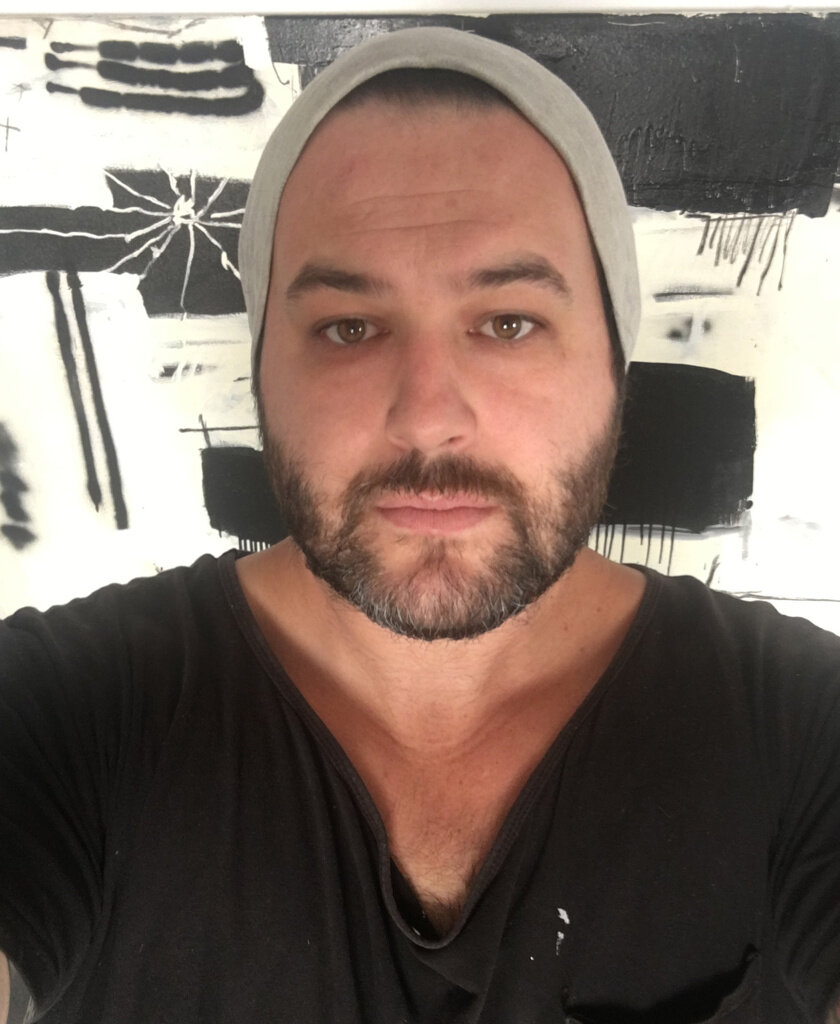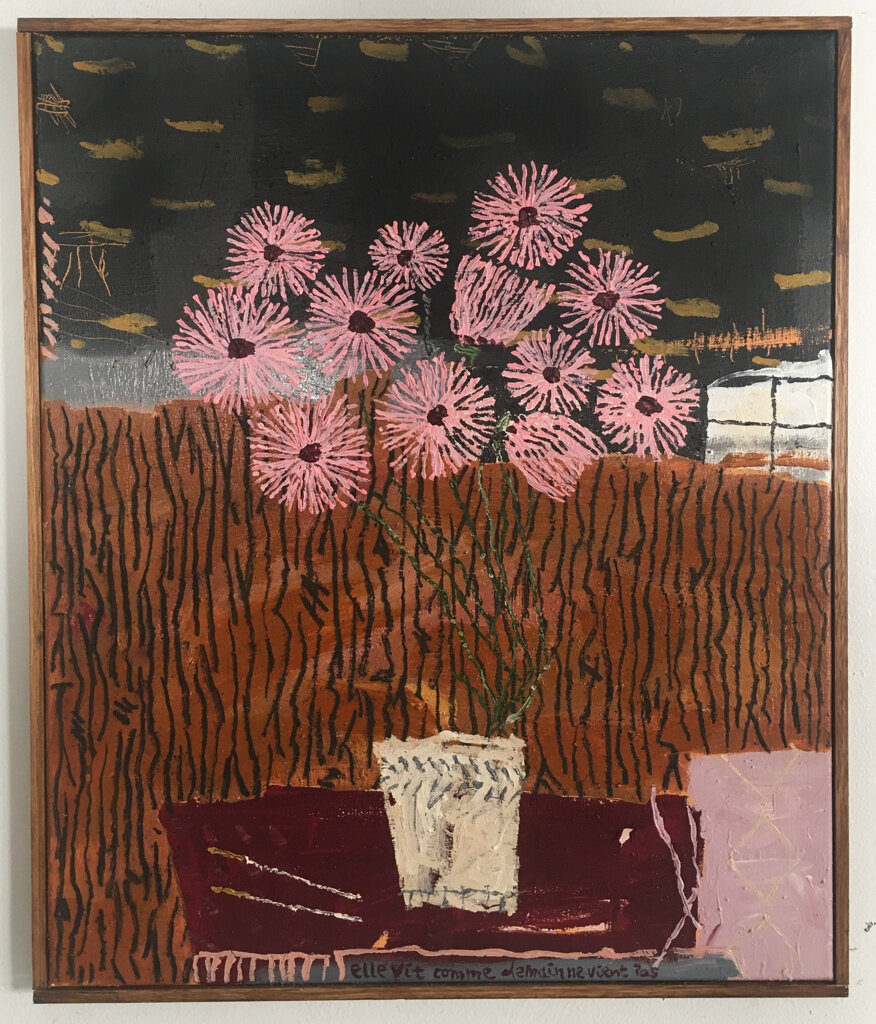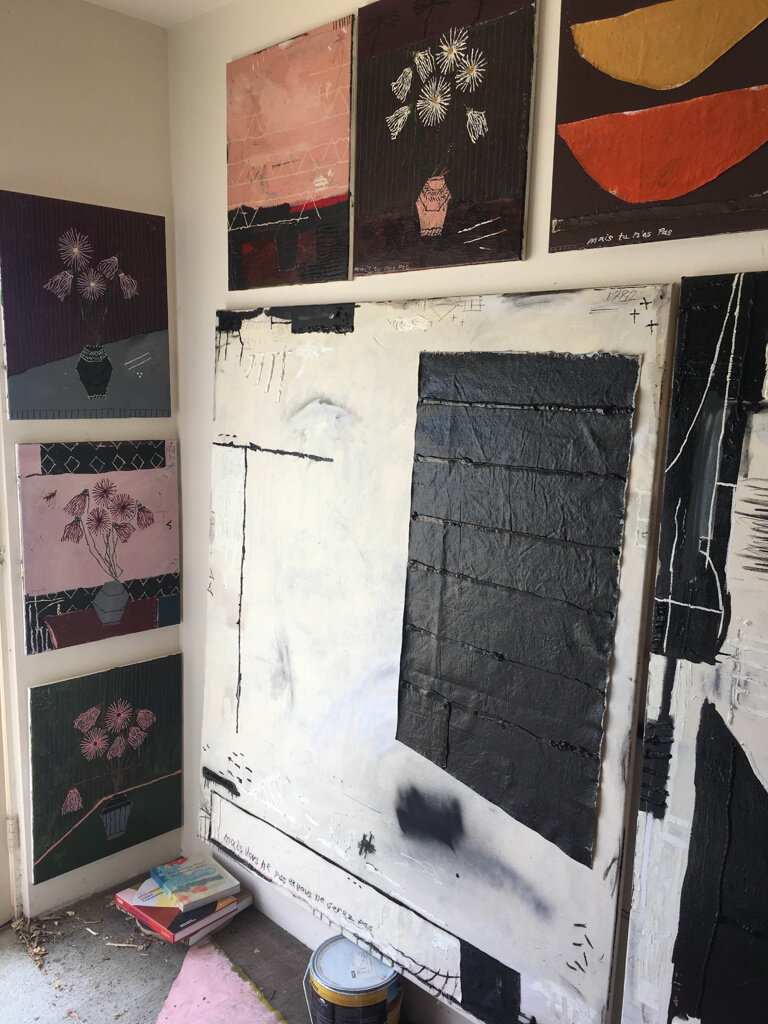Jordy Kerwick




Hunted Projects: Can you tell me a little about yourself and your background? Are you working full-time in your studio?
Jordy Kerwick: I was born in Melbourne, Australia in July 1982. I’m married to a goddess with two naughty boys (Sonny and Milo) and live a pretty simple life. Good music, good books, good podcasts (anything historical, political or paranormal is ace) and as I get older, I seem to be challenging myself to look more and more ungainly (I recommend a yoga pant, flip flop combo for extreme comfort). Our house is full of beautiful art (some bought and some swapped) and we live a few minutes walk to the beach, the botanical gardens and a few pubs. I have a marketing background and have started several university degrees, failing them all miserably (and got turfed out of one for doing so badly).
I’m working full time in the studio these days, which is great, as I’m utterly obsessed with art and painting. I’ve got two little studio mates that keep me company too – Jet and The Boo – Miniature Schnauzers. They don’t judge my work and make me feel slightly less psycho when discussing what I’m doing to myself. My studio is smallish bungalow at the back of our place. I also share a space with a mate for bigger works (Justin Williams – incredible painter)
HP: I am curious if you have a daily working routine? Do you have any morning rituals or habits that contribute towards a productive day within the studio?
JK: I wish I was able to keep a disciplined routine, but I cant. I’ve tried many a time and nail it for a week and then everything goes to shite. It’s not uncommon for me to start work at 8am and finish up at 1am the next morning, stopping intermittently to eat, play with the boys, talk drivel to my wife etc. I’ve always got no less than 10 paintings on the go at any given time and because I switch between figuration and abstraction, I just work on what I feel like (deadline pending).
In the morning, I like to listen to a few podcasts in the morning, British if possible (there is something very soothing about a BBC podcast) and make a horrible, strong black instant coffee. Tastes likes shit but wakes me up. Ill generally draw while drinking this god awful coffee. Nothing detailed, more so playing around with composition and form for larger abstract works and always in black and white and in oil pastels. Subsequently, we have 2 million coloured, unused oil pastels. Then I’ll take a look at what’s happened overnight on Insta. Most of my art mates and galleries I work with are in Europe and the US so we are never in the same time zone. There are a few artists that I look forward to see what they have been working on every morning – makes me want to get better at what I do. Then Ill head to the studio and put on some music that matches my mood and then get started.
HP: Can you please tell me about your studio set up? Would you say that your current studio is ideal, or are you seeking a larger/better space?
JK: My studio is not an amazing space – too small and gets too hot. Psychologically, it prohibits your ability to get loose and gestural (not that being gestural is a massive part of my practice – but I wonder if that’s because of my surroundings???) I line the walls with images and recently finished works that Ill photograph before being sent off. I’ve got a nice little sound system (I’m allergic to silence) and spend at least 50% of my time in the studio sitting and staring. I love the idea of having a bigger space and I think when the boys are a bit older and at school, will get a much bigger space. Painting at home does help a lot though. I love the chaos and liveliness and convenience of it.
HP: To what extent do you consider your city as being an influential factor in the shaping of your work? Do you feel that your surroundings have influenced you in one way or another?
JK: The most influential city on my work to date has been LA. We spent a few weeks there last July and I couldn’t stop scribbling down ideas. It’s dirty and colourful and overcrowded and brilliant. Melbourne is an incredible place to live, but I’m not sure to what level of impact it has had in regards to inspiring or influencing my work. We try to spend as much time as possible in nature, but it doesn’t inspire me. Melbourne has a cool little art scene and there are outstanding galleries, but home doesn’t possess wonderment for me. Not like LA or Paris.
HP: I assume a residency in LA would be perfect for you, is this something you have looked into?
JK: I’d love a residency in LA, but I’m afraid residencies will be taking a back seat for a while due to my little family. I’m pretty reliant on my wife and boys and don’t think I could leave them for an extended period of time. I didn’t do a residency in Madrid last year as it was going to be 30 days without the family (I’m pathetic, I know). But spending some time and absorbing LA and applying the experience to my work would be incredible and (I think) I would see some marked improvement in my works.
HP: In regards to the type of imagery present within your work, there is a focus on both plants and occasionally figures. Would you consider your work autobiographical? Also, how would describe your work to someone who has never seen it?
JK: Any figurative work is never really planned, rather, just evolves from thinking about or seeing a palette that really works. The subject matter (in my eyes) can be largely irrelevant, with more of a planned emphasis on how the colours work together and what kind of textures can be achieved. I think my work is very autobiographical and is a strong reflection of what I’m feeling, what’s happening around me and how I’d like to see the future panning out. The plants and portraits are paintings that ground me and neutralise me after making a somewhat more complex painting or exploring an emotionally draining theme. Painting a few flowers, some ciggies and the occasional illicit or prescribed drug allows me to paint something pretty up top and drag that beauty down through the dirtier aspects of life (smokes and drugs). So after painting a few, I feel more stable and am able to tackle some larger pieces with a clearer mind. They are usually pretty colourful too as I only really wear black, so I get my colour kicks from painting still life.
My work is also very much so a direct reflection of me in real life – I’m pretty raw in my appearance and if I had it my way, would fill every wall from top to bottom with paintings. And I think my paintings are like this – raw and unrefined and unapologetic.
HP: I am interested to know how you plan your works. Do you begin with preparatory sketches of some form, or do you prefer to work in an improvised manner?
JK: I do some very basic planning for abstracted works but the completed painting never turns out the way I’ve planned. Ill also spend a bit of time looking at archived works to see if I can find a mark that will make sense in the new piece. I generally think the painting doesn’t work until the very last few strokes or marks are made. The amount of times I’ve gone to paint over the whole canvas and start again is nuts, but I’ve learned to “finish” the piece, as much as it can be finished, then go between hating it and loving it for the next few weeks.
HP: I am interested in the notion of preciousness and at what stage a painting or work becomes discarded in the studio. You say that you have learnt to complete a work before you deem it failed, but I am interested if you have a tendency to destroy failed paintings?
JK: I wouldn’t say I have a tendency, but if I take it the end and its still shite, I have no problem getting rid of it. If it doesn’t work for me, I’d hate someone to buy it. I’d feel guilty that they don’t have something that I have great pride in. So in this respect, I think its important to either paint over (if possible) or throw it away.
HP: What works are currently in progress in your studio?
JK: I’ve got a solo and a few group shows coming up, so I’m a bit all over the place. Semi-organised chaos. I’m playing around with collage at the moment – really enjoying it and making lots of mistakes, but I guess its all path of the course. I’m also working on some smaller works for shows in Sydney and Hamburg and on some larger mono abstracts. I’ve just finished some work for Kantor Gallery, which, despite their smaller scale, were quite challenging. Trying to ensure that the smaller paintings have the same impact as larger works can take some time to get right (if they “get right” at all). I haven’t shown any work in LA before, so it’s a huge honor to have some works with Kantor Gallery, which has been a stable in the LA art scene since the 1940’s.
HP: I am curious about the documentation of an artworks creation. Within my own studio I regularly take images of paintings in progress so I can note specific points in the works creation. How regularly do you document the progression of your works? Is it important for you to take note of a works evolution?
JK: With smart phones being integrated into just about all aspects of life these days, its hard not to take a billion progress pictures. At any given stage through the making of a painting, I think you get some many other ideas of forms and colours that might work that will be great to reference at a later point. Towards the end of a body of work and inspo/theme have reached their potential, I’ll take a lot less pictures.
HP: What are some of the key items or art materials that you always need to have close to hand?
JK: Always need a palette knife, some horribly used and dirty brushes, antique white paint and at least one of my dogs.
HP: Can you highlight some of your influences and discuss how your influences have made an impact on you and your practice?
JK: There are a number of people that have provided me with inspiration, support, guidance and encouragement along the way, all of whom I appreciate so much and probably never really get to tell them. Painting is funny in that there is no real end game, and it’s when you get to the end, you usually thank those people who have been there. But I think I’ll be painting until the day I kick the bucket. So I’ll need to periodically get around to these people and thank them sincerely for their time and generosity.
From a musical point of view, I think Radiohead, Bob Dylan, Paul Dempsey, Sharon Van Etten, Damien Jurado, Led Zeppelin, WU Lyf (their one album), Neil Young and the Stones have been constant companions that have contributed by virtue of establishing a state of mind that I don’t think I could have achieved. I’m probably missing a fair few from that list.
I can’t really go past Motherwell, Frankenthaler and Twombly as some of the greats that provide the most inspiration and intrigue. I feel kind of cliché listing them, but they aren’t greats for nothing and they were brilliant trailblazers for so much more than just painting.
Authors is also pretty cliché too, but I’ve read a lot of Hemmingway, Camus, Hunter S Thompson, Henry Miller, Simone De Boivoir, Rimbaud (fascinated by his life and genius too), Kafka and Durrell. I’ve had a hard time reading for the past two years due to late nights and early mornings with the boys. I wanted to be a writer for a while, but lack patience, talent and the ability to write, so I don’t think this ambition will be realised.
HP: What future exhibitions do you have scheduled?
JK: I’ve got a bit on the go this year, which I’m eternally grateful for and pretty excited about. I’m in a few really cool group shows in – Denmark, Australia, Germany, USA. A two-man show with Ober Gallery with American painter and mate AJ Katz, and solos in Australia, USA, Spain, and France. I started planning and making the work a few months ago, so at this stage I’m feeling pretty happy with my progress but am at risk of there being too long a time between making the work and sending to the gallery. I have been making a lot of work exploring the theme of the alternate world of the adult industry, living polarised lives at night. It’s fascinating and sad and fake and real all at the same time.
HP: In relation to social media and more specifically Instagram, what are your thoughts on this as a platform to engage with new audiences? Do you have a love/hate relationship with Instagram or other online social media platforms?
JK: I owe HEAPS to Instagram as networking tool. It’s phenomenal how powerful it has been in regards to entering new markets and effectively networking. I’ve met some incredible people through Insta and was lucky enough to meet a lot of them last year in Copenhagen and spend a bit of time with them. Sure enough, they were all great people and it’s amazing how honest and true they were to their persona’s they portray on Insta. I do have a love/hate relationship with Insta – I love the opportunities it has presented and hate that I spend too much time on it.
HP: What do you feel are the pros and cons of Instagram, and do you consider Instagram important for artists working today?
JK: I think the pros out-weight the cons, but like anything else, it’s not a perfect platform. Its shrunk the world and enabled guys like me all the way down in Australia to form meaningful friendships with men and women from all over the world. Making art is such a solitary process, so it’s nice to talk shit with other artists and share triumphs/failures together. Its created a level of healthy competition and definitely spurns people on to want to keep making, wanting to get better and pushing their own limits.
A significant con is that you can spend days/weeks on a piece, finish it, be happy with it, jump on Instagram, peruse it for 15 minutes and see some mind-blowing art and think “fuck…. back to the drawing board”. On the flip side, it’s always nice to get some positive feedback and interest from others when you post a WIP or finished piece. I constantly feel bad that I don’t follow everyone back (who the fuck am I after all???) and really do appreciate the love and support from a lot of people Ill never meet or get to know.
HP: Any last points or thoughts you would like to share?
JK: Just a big and heart felt thank you for taking interest in my work!
